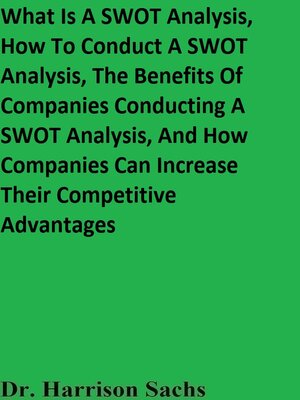What Is a SWOT Analysis, How to Conduct a SWOT Analysis, the Benefits of Companies Conducting a SWOT Analysis, and How Companies Can Increase Their Competitive Advantages
ebook
By Dr. Harrison Sachs

Sign up to save your library
With an OverDrive account, you can save your favorite libraries for at-a-glance information about availability. Find out more about OverDrive accounts.
Find this title in Libby, the library reading app by OverDrive.



Search for a digital library with this title
Title found at these libraries:
| Library Name | Distance |
|---|---|
| Loading... |
This essay sheds light on what is a SWOT Analysis, explicates how to conduct a SWOT Analysis, demystifies the benefits of companies conducting a SWOT Analysis, and reveals how companies can increase their competitive advantages. A SWOT Analysis is able to provide a framework for meticulously analyzing a company's competitive position. The results of a SWOT Analysis cannot only shed light on a company's competitive position, but can also be utilized to inform strategic planning. Exogenous factors and endogenous factors are assessed when conducting a SWOT Analysis. A company's competitive position is affected by both exogenous factors and endogenous factors. Favorable external factors and beneficent internal factors will ameliorate a company's competitive position. On the other hand, unfavorable external factors and adverse internal factors will undermine a company's competitive position. The outcome of a SWOT Analysis is able to efficaciously guide strategic planning in contexts in which it is meticulously conducted. If scant information is provided about a company's "strengths, weaknesses, threats, and opportunities" then it will undermine the practicality of leveraging the SWOT Analysis results for guiding strategic planning. The practicality of leveraging the SWOT Analysis results is the merits of its usefulness in guiding strategy formulation. It is much more of a seamless process to formulate prudent strategies for success on behalf of a company in contexts in which you are able to easily reference meticulously detailed SWOT Analysis results than it is to do so otherwise when you have a dearth of information about the company. The SWOT Analysis is able to shed insights on a company's competitive position and takes into account a company's "strengths, weaknesses, threats, and opportunities". The SWOT Analysis is multifaceted and allows investors to more comprehensively understand a company's competitive position if it is meticulously conducted. Possessing in-depth knowledge about a company's competitive position can help to inform strategic planning. The strength component of the SWOT analysis is able to demystify a company's strengths. The surfeit of strengths of a company can vary from company to company. Some of the strengths that a company may possess for instance can encompass potent competitive advantages, high market share attainment, high net income, innovative product lines, innovative service offerings, the utilization of automated technologies, the diversification of revenue streams, a highly competent workforce, access to a robust supply chain, access to ample distribution chains, ample operational efficiencies, mutually beneficial strategic partnerships, a massive customer base, a sizeable brand advocate base, substantial brand recognition, robust brand equity, strong brand loyalty, a stellar brand image, efficacious marketing campaigns, and a behemoth brand across ample social media platforms. When a company attains some of these aforementioned strengths then it becomes easier for them to be able to compound their strengths overtime, especially as a company makes inroads towards becoming a major market competitor in the niche markets that it vies for market share in. Perhaps the utmost three important strengths that a company can possess are high market share attainment, innovative product lines, and potent competitive advantages. It is easier to obtain high net income when companies possess high market share attainment, innovative product lines, and potent competitive advantages than it is to do so when they lack these aforementioned strengths. The weakness component of the SWOT analysis is able to demystify a company's weaknesses. The various weaknesses...







